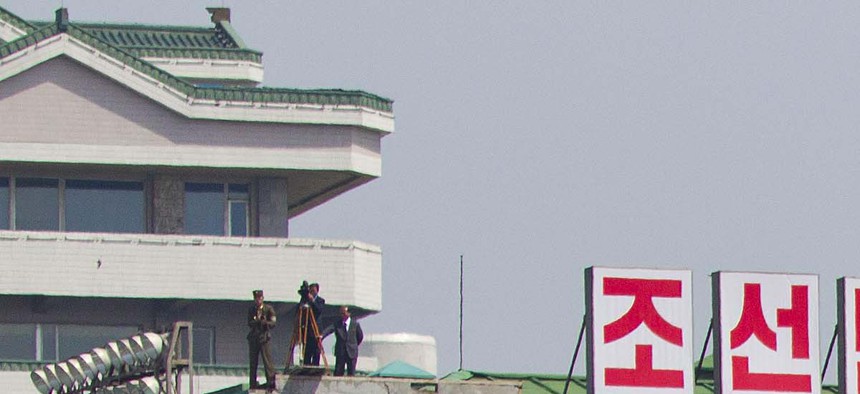
North Korea claims it already has developed ICBMs like this missile paraded in Pyongyang. David Guttenfelder/AP
North Korea Is Making Progress on an ICBM
Some experts believe that Pyongyang may be edging towards 'limited intercontinental capability' using domestically produced missile technology. By Rachel Oswald
While some weapons experts agree North Korea appears to have improved the designs for it newest intercontinental-ballistic missile, they are not in agreement over just how much headway the secretive nation has made.
Simulations of the North's new road-mobile ICBM, known in the West as the KN-08, were first seen at an April 2012 military display in Pyongyang. Those mockups were criticized by international technical specialists as being fake and shoddily put together. The North may have taken those criticisms to heart, though, because the mockups it rolled out at a July parade this year did not have many of the design inconsistencies noticed before, according to experts.
"Although small discrepancies still exist among the six missiles seen in 2013, the major differences in 2012 are no longer evident," Jeffrey Lewis and John Schilling write in a new analysis for 38 North published on Monday. Lewis is the director of East Asia nonproliferation studies at the James Martin Center and Schilling is a rocket engineer for the Aerospace Corporation.
Improvements over the designs seen in 2012 include "fuel ports are in the same place, the missiles are properly secured [to their transporter vehicles] and the pointy end is smooth and shiny," they say.
Additionally, the KN-08 mockups seen this year had fewer design discrepancies between them when compared to differences spotted among the missile versions paraded in 2012. Taken together, these changes suggest the blueprints for the ICBM have largely solidified, according to the 38 North analysis.
Lewis and Schilling see evidence from the new mockups that Pyongyang is advancing toward a workable design for a ballistic missile with what they termed a "limited intercontinental capability using only North Korean technology."
However, German aerospace engineer Markus Schiller disagrees that Pyongyang has stabilized its design of the KN-08.
"They certainly improved the mockups but I would never say that they are finalizing the design," Schiller said in a Tuesday interview. "They definitely are better than the last ones in April 2012 but there are still some minor things that are outright wrong."
Schiller declined to specify exactly what technical issues remain unaddressed in the latest mockups, saying that he and his engineer colleagues at Schmucker Technologie do not want to give the North any hints about how it can improve its ICBM designs.
"We want to keep that to us and see if they figure that out for ourselves," said Schiller, an expert on North Korea's missile forces. "I'm pretty sure they will parade that stuff next year and I'm looking forward to seeing if they have found these wrong mistakes by themselves."
North Korea's first ICBM, the Taepodong 2, had its first successful fully staged launch in December 2012. The missile has yet to be test fired again. Schiller noted mockups for the Taepodong 2 were first seen in the early 1990s but it was not until 2006 that the weapon -- under the cover of a peaceful satellite rocket launch -- was first unsuccessfully flight-tested.
The KN-08 has never had a flight test.
South Korean intelligence officials on Tuesday said the North so far this year has carried out five rocket engine tests at its Dongchang-ri missile site, according to a Yonhap News Agency report.
Schiller said other than reports of such static engine tests, there is not much recent evidence to suggest North Korea is making advances in its ICBM work.
"If you look at their past records of rocket work, it could be that they are working on a rocket design but it could be 20 years before we see something fly," he said.
NEXT STORY: How Egypt's Muslim Brotherhood Can Come Back
